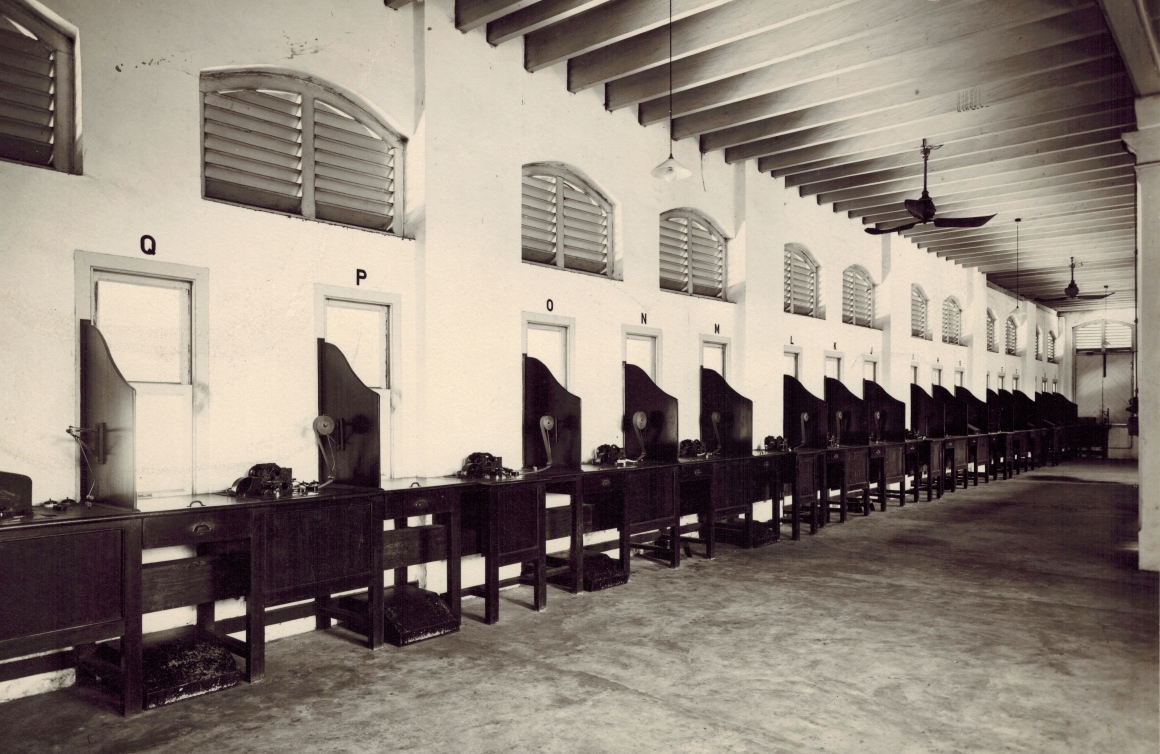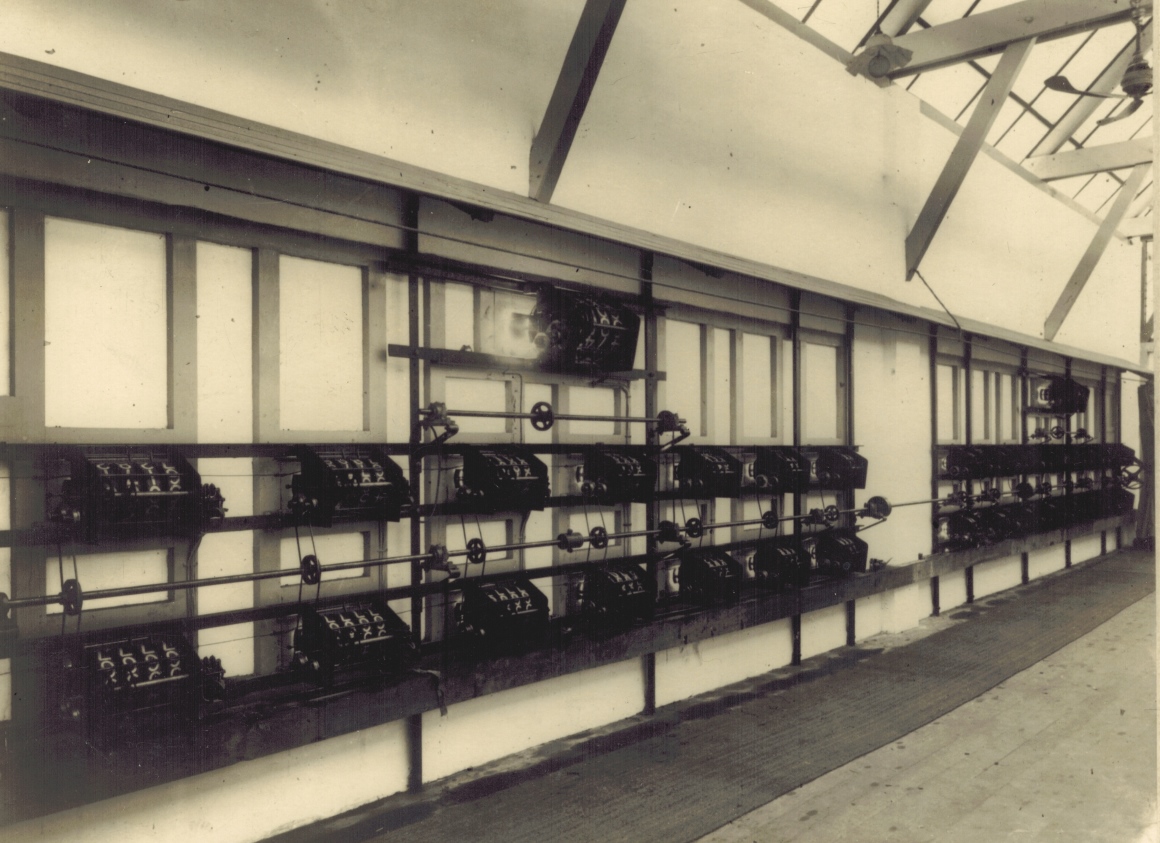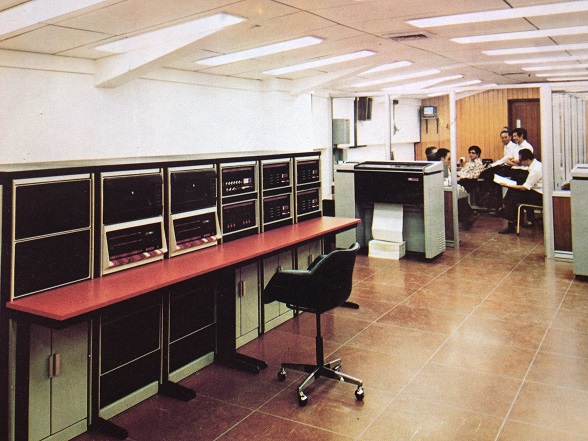This history page contains a photograph which is one of several belonging to the photo gallery pages which are part of several pages relating to the invention of the world's first automatic totalizator in 1913 and Automatic Totalisators Limited, the company founded in 1917 by George Julius to develop, manufacture and export these systems.
The Singapore Tote House
This photograph was taken at the Singapore Turf Club showing the selling room in the tote house and the sixteen J5 Ticket Issuing Machines (TIMs) at each window, installed in Singapore in 1926. The main part of the TIMs are hidden inside the bench with only the top cover protruding above the bench. Each partition has a paper-roll holder and feeder holding a paper roll which feeds paper to the Ticket Issuing Machine. It is interesting to note that there appear to be foot rests at each selling window presumably for operators sitting on stools. I find this astounding to see what today is an Occupational Health and Safety issue, dealt with in 1926. This seems to be an example of very progressive thinking!
I started in the totalisator industry in 1977 and it would take another decade at least before this subject would even start to be mentioned. Prior to this, there were what now would be considered a variety, some of which would be regarded as major, OH&S violations taking place. In those earlier times this was just normal practice and OH&S did not appear to exist as it had not yet become widely adopted. After the first glimmering of OH&S becoming established, it would take decades more to overcome the inherent resistance that most employees seemed to have to these issues, with no shortage of vocal critics. The introduction of OH&S principles, which I had a part in, had the propensity to lead to arguments.

Click on the image to go back to the Photo Gallery
There is no photographer's stamp on this photograph.
Following are two extracts from the newspaper Western Mail Perth, provided by the Trove Digitised Newspaper Archive, titled Singapore Turf Club under the sub heading History and Progress.
The citation: 1937 'HISTORY and PROGRESS', Western Mail (Perth, WA : 1885 - 1954), 18 March, p. 39. , viewed 26 Aug 2017, http://nla.gov.au/nla.news-article38903759
It has been said that, upon the acquisition of lands by Great Britain, the first act of the average Englishman on arrival is to select a site suitable for a cricket ground, whereas his cousins, the Australian and the New Zealander, look around for a site suitable for a racecourse. No doubt, records are in existence of the establishment of a cricket club soon after the arrival in Singapore of Sir Stamford Raffles, in 1819, but it was not until 1843 that serious attempts were made by the local sportsmen to found a racing club; and in that year the Singapore Sporting Club came into existence. The club continued to flourish under that name until 1924, when the name was altered to the Singapore Turf Club.
...
The totalisator is the medium of betting in the Straits Settlements, and the Federated Malay States, and the tote machine installed in Singapore is the Julius machine, popularly known as the automatic totalisator. The machine is an invention of Sir George Julius, of New Zealand, and similar machines are installed on most of the important race-courses in Australia, New Zealand, India, Burmah, and Ceylon, as well as at Longchamps. Bookmaking is illegal in the Settlements and P.M.S.
The image below shows the Singapore machine room inside the tote house which is on the first floor above the selling windows shown in the image above.
Singapore Julius Tote Machine Room

The combined adder and Display units can be seen in the above image as two long rows of equipment. There are two banks of these units, the far bank is for the Win Pool and the near side bank for the Place Pool. There is a adder/display unit for every possible runner in a race. In the nearest two adder/display units the adder section can be just discerned protruding out on the lower right hand side of the counter wheels. These consist of escapement wheels, escapement mechanisms and epicyclic gears. The escapement mechanisms contain solenoids which receive pulses from the J5 TIMs, shown on the bench at each selling window in the image at the top of the page, via a front end system. The pulses from the TIMs activate the solenoids which release the escapement wheels to move a single tooth per pulse. There is a full sized version of the image above in the photo gallery which precedes the one at the top of this page. To view this, click on the image at the top of the page and scroll up to and select the previous image thumbnail to that associated with the image at the top of this page.
An Automatic Totalisators Limited product promotion document titled The PREMIER (JULIUS) AUTOMATIC TOTALISATOR has a low resolution copy of a photograph like the one in the image at the top of this page. The primary differences are that the one in the document has a slightly more distant view which includes the bank in this tote house on the right hand side and there are staff in that photo. The annotation for that photograph reads: FIG. 40. Interior of the ticket selling room Singapore Turf Club Totalisator Building. There is an image of the associated page in the Automatic Totalisator product promotion document, in the photo gallery of this website. To view this, click on the image at the top of the page and scroll down to the section titled Miscellaneous Images and select the image thumbnail with associated text starting This is a page extracted from a company document titled The PREMIER (JULIUS) AUTOMATIC TOTALISATOR.
Following are two extracts from the Automatic Totalisators Limited company magazine titled Tote Topics, Winter 1978 edition. It relates to Singapore totalisator in the computer era, 52 years after the Julius Tote was installed:
There are approximately 2,500 people dependent on racing living on the property. The Club houses its own labour force in a model village with shops, mosque and temple. Racing facilities include the most modern types of Totalisator Equipment. There is Photo Finish and Camera Patrol Equipment with closed-circuit colour television which provides a complete coverage of the races by television and cine-cameras. The grandstand affords excellent facilities to racegoers and has seating for more than 5,000 people. There are electric lifts and escalators serving all floors, some of which are partly air conditioned.
...
The A.T.L. Electronic Totalisator installation is geared to operate on race meetings in Singapore and also operates when race meetings are held in Malaya. The club also operates betting terminals at their office in Cecil Street from 9A.M. up to the last race. This office is many miles from the course. Win, Place and Forecast tickets are on sale at all Pay-in windows. ...
Following is an image of the A.T.L. (Automatic Totalisators Limited) Electronic Totalisator in Singapore. It was developed by ATL and was based on two PDP11 minicomputers manufactured by DEC (Digital Equipment Corporation) the world's number two computer company in the latter part of the 1900s. The PDP11 consoles can be seen in the second and third racks from the left, just above the desk that runs along the front of the racks.
The comparison of the 1970s implementation of a totalisator in the image below using minicomputer systems, provides an interesting contrast with the 1920s electromechanical implementation in the image above. A lot has been written comparing and contrasting these technologies so I am not going to get carried away with that here. One interesting comparison however is that the system shown in the image above supported 16 terminals, although a Julius tote was built and tested capable of supporting 1000 terminals with massively more hardware, the system below supported 256 terminals, which also was not a limit with support for more machines not incurring significant increase in hardware. Some articles comparing and contrasting these technologies can be read on this website. To read this, click on the image at the top of this page, scroll down to the image thumbnail section titled Miscellaneous Images and select the image thumbnail associated with the text starting An early ATL Computer Tote System. Scroll down to three articles in this page titled Electronic Totalisators I through Electronic Totalisators III
The Computer Room in Singapore

And finally, a rather comical anecdote from Singapore: I recall a trip to Singapore to assist with a Totalisator demonstration to the Singapore Turf Club, to be conducted on DEC's (Digital Equipment Corporation's) premises.
We organised a taxi on the day of the demonstration. When it arrived, the Research and Development Manager, Phil White, sat in the front and the Marketing Manager, John Pickering and myself sat in the back. The R&D manager delivered a greeting to the taxi driver followed by a suburb name. This was met by silence and an expressionless face. The taxi driver could not speak English and did not recognise the suburb. The R&D manager gave a street name with the same result. The company's frequent travellers generally prided themselves on their knowledge of these foreign ports and the R&D manager took on the challenge of conveying to the taxi driver our destination. He tried neighbouring suburbs and roads near the destination without any response. He remembered a large hospital across the road from our destination however after naming it, the driver's expressionless face and silence persisted. The R&D manager really thought he had solved the problem when he remembered the Ferrari dealer on the ground floor of the building we needed to get to. Surprisingly the name Ferrari did not solicit any recognition.
In desperation after ten minutes of grappling with the problem, the R&D manager turned to us in the back and gasped "I don't think we are ever going to get to Digital". The taxi driver's head swung around, his eyes ablaze he exclaimed "Ah you want go Digital"! I don't think John or I had laughed so much in a very long time.


